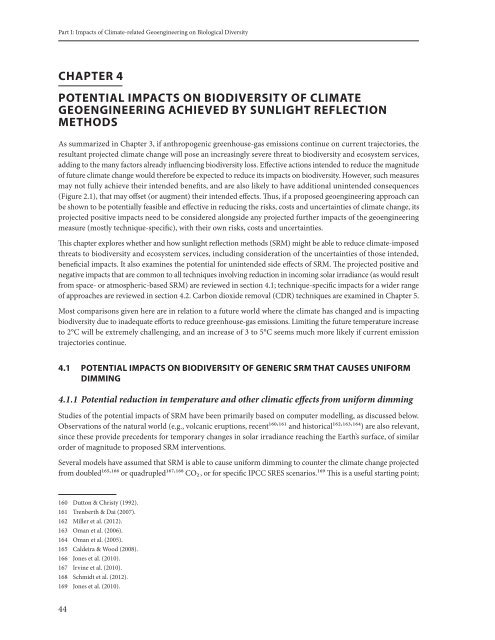cbd-ts-66-en
cbd-ts-66-en
cbd-ts-66-en
Create successful ePaper yourself
Turn your PDF publications into a flip-book with our unique Google optimized e-Paper software.
Part I: Impac<strong>ts</strong> of Climate-related Geo<strong>en</strong>gineering on Biological Diversity<br />
CHAPTER 4<br />
POTENTIAL IMPACTS ON BIODIVERSITY OF CLIMATE<br />
GEOENGINEERING ACHIEVED BY SUNLIGHT REFLECTION<br />
METHODS<br />
As summarized in Chapter 3, if anthropog<strong>en</strong>ic gre<strong>en</strong>house-gas emissions continue on curr<strong>en</strong>t trajectories, the<br />
resultant projected climate change will pose an increasingly severe threat to biodiversity and ecosystem services,<br />
adding to the many factors already influ<strong>en</strong>cing biodiversity loss. Effective actions int<strong>en</strong>ded to reduce the magnitude<br />
of future climate change would therefore be expected to reduce i<strong>ts</strong> impac<strong>ts</strong> on biodiversity. However, such measures<br />
may not fully achieve their int<strong>en</strong>ded b<strong>en</strong>efi<strong>ts</strong>, and are also likely to have additional unint<strong>en</strong>ded consequ<strong>en</strong>ces<br />
(Figure 2.1), that may offset (or augm<strong>en</strong>t) their int<strong>en</strong>ded effec<strong>ts</strong>. Thus, if a proposed geo<strong>en</strong>gineering approach can<br />
be shown to be pot<strong>en</strong>tially feasible and effective in reducing the risks, cos<strong>ts</strong> and uncertainties of climate change, i<strong>ts</strong><br />
projected positive impac<strong>ts</strong> need to be considered alongside any projected further impac<strong>ts</strong> of the geo<strong>en</strong>gineering<br />
measure (mostly technique-specific), with their own risks, cos<strong>ts</strong> and uncertainties.<br />
This chapter explores whether and how sunlight reflection methods (SRM) might be able to reduce climate-imposed<br />
threa<strong>ts</strong> to biodiversity and ecosystem services, including consideration of the uncertainties of those int<strong>en</strong>ded,<br />
b<strong>en</strong>eficial impac<strong>ts</strong>. It also examines the pot<strong>en</strong>tial for unint<strong>en</strong>ded side effec<strong>ts</strong> of SRM. The projected positive and<br />
negative impac<strong>ts</strong> that are common to all techniques involving reduction in incoming solar irradiance (as would result<br />
from space- or atmospheric-based SRM) are reviewed in section 4.1; technique-specific impac<strong>ts</strong> for a wider range<br />
of approaches are reviewed in section 4.2. Carbon dioxide removal (CDR) techniques are examined in Chapter 5.<br />
Most comparisons giv<strong>en</strong> here are in relation to a future world where the climate has changed and is impacting<br />
biodiversity due to inadequate effor<strong>ts</strong> to reduce gre<strong>en</strong>house-gas emissions. Limiting the future temperature increase<br />
to 2°C will be extremely chall<strong>en</strong>ging, and an increase of 3 to 5°C seems much more likely if curr<strong>en</strong>t emission<br />
trajectories continue.<br />
4.1 POTENTIAL IMPACTS ON BIODIVERSITY OF GENERIC SRM THAT CAUSES UNIFORM<br />
DIMMING<br />
4.1.1 Pot<strong>en</strong>tial reduction in temperature and other climatic effec<strong>ts</strong> from uniform dimming<br />
Studies of the pot<strong>en</strong>tial impac<strong>ts</strong> of SRM have be<strong>en</strong> primarily based on computer modelling, as discussed below.<br />
Observations of the natural world (e.g., volcanic eruptions, rec<strong>en</strong>t160, 161 and historical162, 163, 164) are also relevant,<br />
since these provide preced<strong>en</strong><strong>ts</strong> for temporary changes in solar irradiance reaching the Earth’s surface, of similar<br />
order of magnitude to proposed SRM interv<strong>en</strong>tions.<br />
Several models have assumed that SRM is able to cause uniform dimming to counter the climate change projected<br />
from doubled165, 1<strong>66</strong> or quadrupled167, 168 CO2 , or for specific IPCC SRES sc<strong>en</strong>arios.169 This is a useful starting point;<br />
160 Dutton & Christy (1992).<br />
161 Tr<strong>en</strong>berth & Dai (2007).<br />
162 Miller et al. (2012).<br />
163 Oman et al. (2006).<br />
164 Oman et al. (2005).<br />
165 Caldeira & Wood (2008).<br />
1<strong>66</strong> Jones et al. (2010).<br />
167 Irvine et al. (2010).<br />
168 Schmidt et al. (2012).<br />
169 Jones et al. (2010).<br />
44


